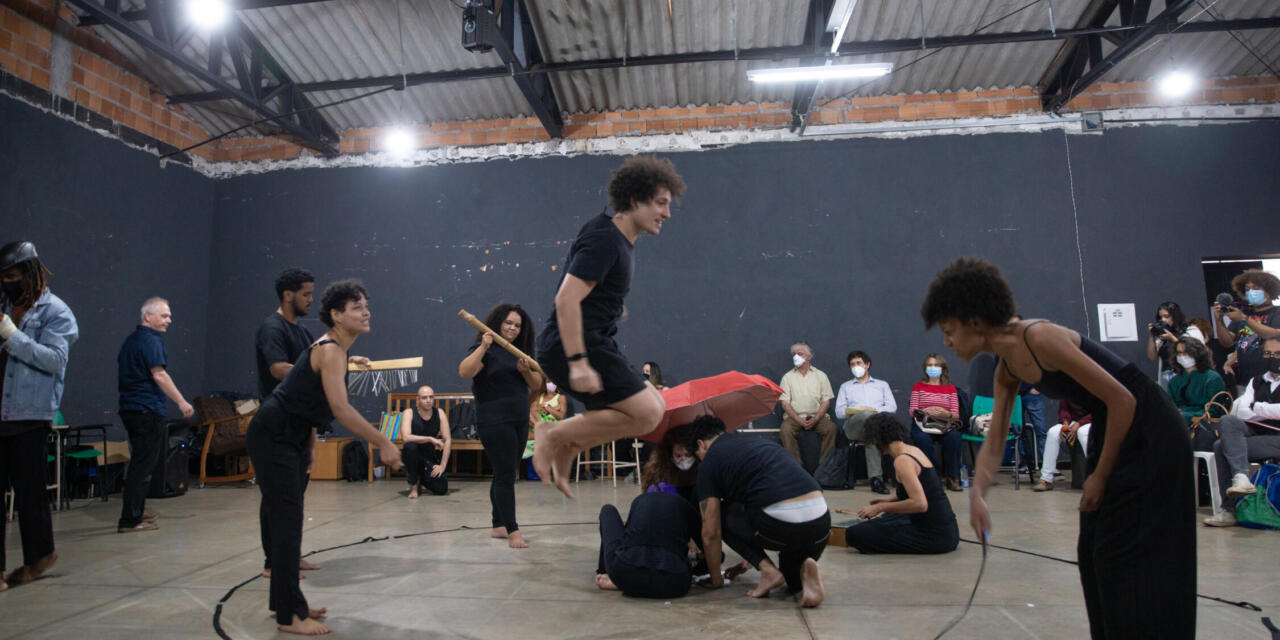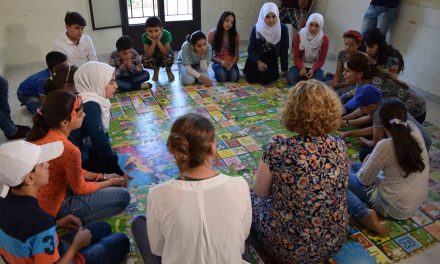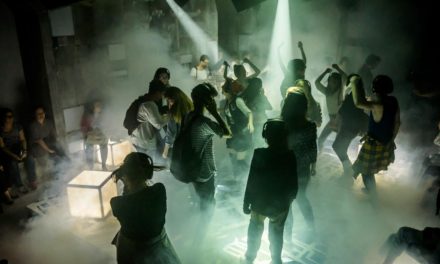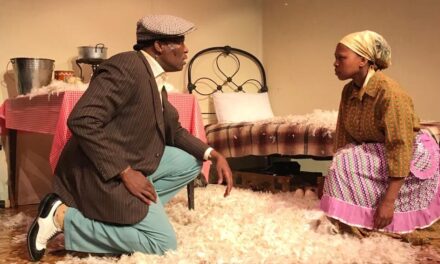An ambitious plan to fly from Gdańsk, Poland to Goiânia, Brazil and co-organize as well as lead a four-day festival was realized by Tomasz Wiśniewski and Martin Blaszk in June 2022. The festival, titled ENTRE, took place from Wednesday 8th to Saturday 11th June 2022, and comprised of three days of laboratory work in the form of seminars and workshops, resulting in a fourth day of discussion and performances. The festival was hosted by Teatro Escola Basileu França (Basileu França Theatre School), Goiânia, Brazil and was open to staff and students from the Federal University of Goiás and the Basileu França Theater School, and actors from Máskara – the Transdisciplinary Center for Research in Theatre, Dance and Performance, as well as, on the fourth day, members of the general public. In addition, on Monday 13 June, there was a special event co-organised with the SP Escola de Teatro, São Paulo, Brazil. Twenty participants were invited to take part in ENTRE: a Samuel Beckett Laboratory – ways of physically exploring personal reactions to the 20th century Parisian/Irish master of literature and theatre.
The initial impulse for these two strands of ENTRE was a long-term cooperation between the Federal University of Goiás, Department of Performance and Theatre Studies and the University of Gdańsk, Department of Performance and Theatre Studies and the Between.Pomiędzy Foundation. Theater director, researcher and academic teacher Robson Corrêa de Camargo and a team that included the actors Mariana Tagliari, Ronei Vieira and Valéria Livera, had already visited Gdańsk and worked with actors as well as students from that University to devise and present a performance based upon Samuel Beckett’s Company in 2018.[1]Professor Robson Corrêa de Campargo had also visited in 2010 in connection with Between. Pomiędzy Festival of Theatre and Literature. Now it was the turn of representatives from the University of Gdańsk, Department of Performing Arts and Between.Pomiędzy, Wiśniewski and Blaszk, to travel to Brazil and work with actors and students from Goiânia.
ENTRE festival – Teatro Escola Basileu França
The laboratory work done over the first three days of the ENTRE festival was titled Geography of Imagination. The structure of the seminars and workshops was worked out in advance of the visit by Wiśniewski and Blaszk. However, at the end of each day’s laboratory, the content was ‘reassessed’ to take into account what had been learned by the providers in collaboration with the participants. There were also moments during the seminars and workshops when content was changed in reaction to what was occurring at the given moment.
The seminars were led by Wiśniewski and focused on different approaches to theatre, literature and other forms of art, including films, photographs and books. As a framework for containing such diversity, the content was conceptualized in terms of the local, the countrywide (national) and the global. In connection with this, Wiśniewski also presented artists of various disciplines from around the world who had collaborated with Between.Pomiędzy Festival of Literature and Theatre in Poland, which had recently celebrated the launch of its thirteenth edition as a dispersed festival. The people who Wiśniewski talked about included David Malcolm (Sopot), Jon McKenna (London), Marcello Magni (London), Debbie Mulholland (New Zealand), Paula Meehan (Ireland), Mimi Khalvati (UK), and Lee Ranaldo (New York). In addition to this, the Irish writer Samuel Beckett and the Polish writer Tadeusz Różewicz were discussed, as well as the theater group Complicité, different proponents of physical theatre, educational happening and various forms of modern and contemporary poetry.
The original concept for the workshops was that they would explore ideas connected with physical theatre and educational happening using a framework similar to the one in the seminar: the local, the countrywide and the global. In the workshops, therefore, there were activities and exercises inspired by different theater directors: Jacque Lecoq from France, Tadeusz Kantor from Poland and Augusto Boal from Brazil. In addition to this, “the local” became work with and on “the individual,” where there were exercises in which participants explored their own physical potential, the space in which they found themselves and the objects they had to hand; “the countrywide” became work in pairs and smaller groups, as well as a whole group activity; while “the global” was the whole group working together to produce a performance. This way of thinking about the workshops translated into a number of different activities which were used during the three days of their operation and culminated in a performance on the fourth day of ENTRE.
On the fourth day of the festival, Saturday 11th June, ENTRE was opened to the general public and a number of events took place. In the morning, there was the launch of a resource pack on Samuel Beckett and Tadeusz Różewicz in Portuguese and the showing of the short film Beckett on the Baltic by S.E. Gontarski (USA). In addition to this, there was a “festival of poems” in which everyone present was invited to bring and read the poems they love in their own languages, including the indigenous Brazilian languages. This started with Brazilian music by Nana Vasconcelos: E o negão entrou na roda pra não mais sair! Saia! There was also a haunting song sung by Nina Soldera.
Two enactions were presented in the morning session of the festival. The first was the happening which was the conclusion of Blaszk’s three day workshop. This, after its presentation, was given the title A Tempest; although in the best tradition of happening, the audience was left to make up their own minds about its meaning. The second enaction resulted from a workshop led by Adriana Fernandes, The Voice on Stage – Affections and Emotions, which also took place as part of the ENTRE festival. In the enaction, breath, voice and body were used to create an inter-play between actors in which they spun and weaved around the performance space exploring and sharing personal histories in a mesmerizing enaction.
In the evening, there was a celebration of the 20th anniversary of the Máskara Theater, where the group performed the work of Samuel Beckett titled Quê Onde (What Where when translated into English). This displayed a masterly use of controlled physicality and modulation of voice, in which costumes and lighting played a major role, to give full expression to themes that are prevalent in Beckett’s work.
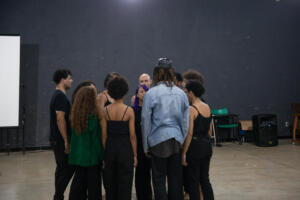
Photographs by André Miranda.
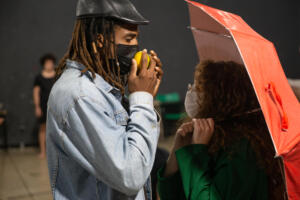
Photographs by André Miranda.
ENTRE at the São Paulo Escola de Teatro
ENTRE: a Samuel Beckett Laboratory took place at the SP Escola de Teatro, São Paulo. As with the laboratory in Goiânia, it consisted of two components: a seminar followed by a workshop. However, unlike Goiânia, in São Paulo it had a duration of two hours. Prospective participants of the laboratory had been asked to bring an extract of a Beckett text they wanted to explore in the workshop component. In the first part of the laboratory, which lasted approximately 30 minutes, Wiśniewski presented the idea of the Entre festival and a brief outline of some of the main concepts and figures linked to Polish theatre – an abridged version of the series of seminars in Goiânia – and their connections with Samuel Beckett. In this, he made links between Beckett and the Polish writer Tadeusz Różewicz, as well as the work of the Polish theater theoretician and director Jerzy Grotowski and the artist and theatre director Tadeusz Kantor. The seminar component of the laboratory finished with an image well-known to followers of Polish art and theatre: Eustachy Kossakowski’s black and white photograph of a happening by Kantor, The Sea Concert part of The Panoramic Sea Happening (1967). In the image, a line of people dressed in swimming costumes sit in deckchairs on the shoreline and are splashed by incoming waves. Meanwhile, they watch a man formally dressed in a frock coat on a podium trying to conduct the sea. Indeed, this image served as an inspiration for the beginning of the laboratory workshop.
For the first part of the workshop component, the participants were split into small groups of two or three people and then asked to interpret Kossakowski’s image using body and voice in ways they felt to be appropriate. This resulted in a number of interpretations in which the sea and the podium were significant. One of these involved two men who, through the repetition of a crouching run backwards and forwards, followed by one man leaping onto the other man’s shoulders, became the movement of the sea along the shoreline and then the podium and conductor. Another presentation had a man and a woman fastened together in a back-to-back wrestling clinch who moved forwards and backwards across the floor to become the energy of rolling waves. In a third interpretation, a chair-podium was mounted from which the three individuals in the group fought to become the politician in front of an audience at a political rally. After these presentations, in which the groups had ten minutes to prepare and two to three minutes to present, there was a whole group discussion in which all the participants, the actors and the facilitators (Blaszk and Wiśniewski), commented upon what they had witnessed. Following this, the participants were re-grouped and asked to share and investigate the extracts of Beckett texts they had chosen to bring to the workshop. At this point, a poem by Beckett was also projected – “what is the word” – so that those participants who did not have a chosen extract would have a text from which to work.
In this, the second part of the workshop component, the actors had fifteen minutes to prepare, with a two to three-minute presentation time. In the resulting interpretations, the Beckett extracts were inspirations for actions and text that were intermingled with the etudes from the first part of the workshop. In this way, what appeared to be continuations of the previous presentations were produced or completely new interpretations were given. One such improvisation developed the politician-podium presentation shown in the first part of the workshop. For this, one speaker, Man 1, climbed onto the podium (chair) and began to recite numbers in descending order – “One thousand nine hundred and eighty-five, one thousand nine hundred and eighty-four, one thousand nine hundred and eighty-three(…)”, only to be interrupted by his colleague, Man 2, who pulled him down and carried him away across his shoulder. Man 2 then returned to continue the count from where Man 1 had left it. Man 2 was then carried off by Man 1, who then returned to carry on the count in a similar way. With its repetition it “implied” the circularity of the Beckett text which inspired it: What Where. The numbers also had a significance; a countdown of the years of dictatorship that Brazil experienced between 1964 and 1985. In this case, with its overtones of bleakness and oppression, Beckett’s What Where was an appropriate inspiration.
The original idea of ENTRE was that it would focus on diverse but complementary ways of approaching theatre, literature and other forms of art, and that it would be mixture of lectures, discussions, experiments, and practical workshops. This was certainly the case. There was also the intention that the festival would be an intense and thought-provoking encounter between scholars, students and theatre-makers where, in addition to practical hands-on experience, films, photographs, books and poetry would be shared. This also occurred. Moreover, it was done in ways that fostered interest and creative responses, as well as giving all those involved the opportunity to come into contact with a broad range of artistic visions. One can only hope that the creative energies that came together across the geographies of imagination to produce the ENTRE festival can be brought together again in a continuation of what, in 2022, was one of the successes of the Between.Pomiędzy Dispersed Festival working in collaboration with institutions in Goiânia, the Federal University of Goiás, the Basileu França Theater School, and Máskara Theater Company, in addition to the SP Escola de Teatro, São Paulo.
This text was written with the support of Between.Pomiędzy Research Group.
This post was written by the author in their personal capacity.The opinions expressed in this article are the author’s own and do not reflect the view of The Theatre Times, their staff or collaborators.
This post was written by Martin Blaszk.
The views expressed here belong to the author and do not necessarily reflect our views and opinions.
Notes
| ↑1 | Professor Robson Corrêa de Campargo had also visited in 2010 in connection with Between. Pomiędzy Festival of Theatre and Literature. |
|---|

